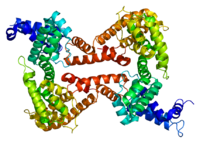
Photo from wikipedia
AbstractVitamin D3 and its metabolites are lipophilic molecules with low aqueous solubility and must be transported bound to plasma carrier proteins, primarily to vitamin D binding protein (DBP). The biological… Click to show full abstract
AbstractVitamin D3 and its metabolites are lipophilic molecules with low aqueous solubility and must be transported bound to plasma carrier proteins, primarily to vitamin D binding protein (DBP). The biological functions of vitamin D3 metabolites are intimately dependent on the protein, hence the importance of determining their affinity for DBP. In this study, we developed a novel procedure for measuring the kinetic and equilibrium constants of human-DBP with vitamin D3 and three metabolites: 1,25-dihydroxyvitamin D3 [1,25(OH)2D3], 25-hydroxyvitamin D3 (25OHD3) and 24,25-dihydroxyvitamin D3 [24,25(OH)2D3] by surface plasmon resonance (SPR). At the same time, five different analogues, synthetized in our laboratory, were evaluated in order to compare the affinity values with the metabolites. Real-time SPR measurements showed that 25OHD3 and 24,25(OH)2D3 had higher affinity (0.3 μM) than 1,25(OH)2D3 (5 μM), with the higher affinity of 25OHD3 and 24,25(OH)2D3 due to dissociation constants 1 order of magnitude slower. In the case of the analogues, the affinity values were lower, with 1-hydroxy-25-nitro-vitamin D3 (NO2-446), structurally closer to 1,25(OH)2D3, showing the highest value with a KD of 50 μM. (24R)-1,25-dihydroxyvitamin-24-buthyl-28-norvitamin D2 (Bu-471) and (24R)-1,25-dihydroxyvitamin-24-phenyl-28-norvitamin D2 (Ph-491), structurally similar, had affinities of 180 and 170 μM, respectively. (22R,23E)-1-hydroxy-22-ethenyl-25-methoxy-23-dehydrovitamin D3 (MeO-455) and 1-hydroxy-20(R)-[5(S)-(2,2-dimethyltetrahydropyran-5-yl)]-22,23-dinor vitamin D3 (Oxan-429) had affinities of 310 and 100 μM, respectively. The binding of the metabolites and analogues was reversible allowing the rapid capture of data for replicates. The kinetic and equilibrium data for both the metabolites and the analogues fitted to the Langmuir model describing a 1:1 interaction. Graphical AbstractLabel-free, real time binding study between vitamin D binding protein immmobilized on the surface of a SPR sensor chip and the vitamin D, metabolites and analogues passed over it as analytes
Journal Title: Analytical and Bioanalytical Chemistry
Year Published: 2017
Link to full text (if available)
Share on Social Media: Sign Up to like & get
recommendations!